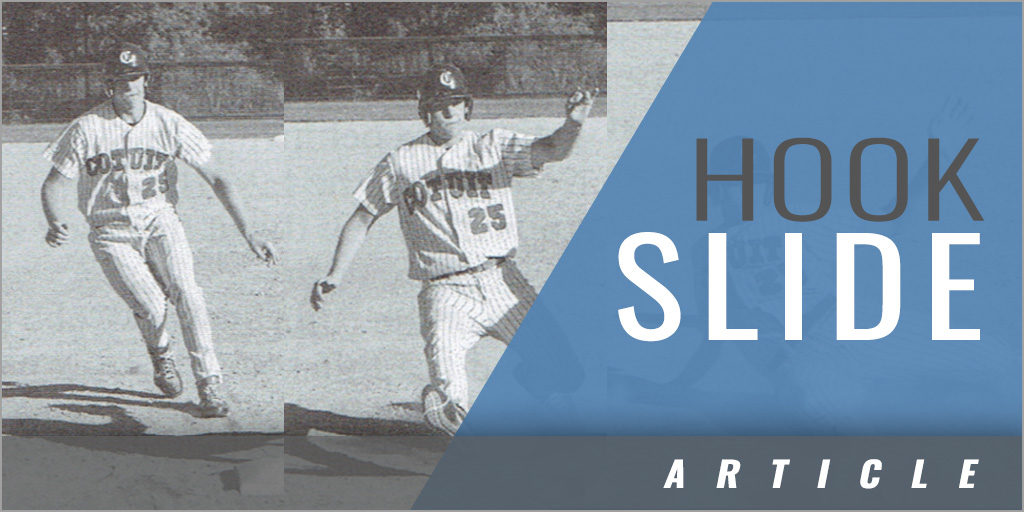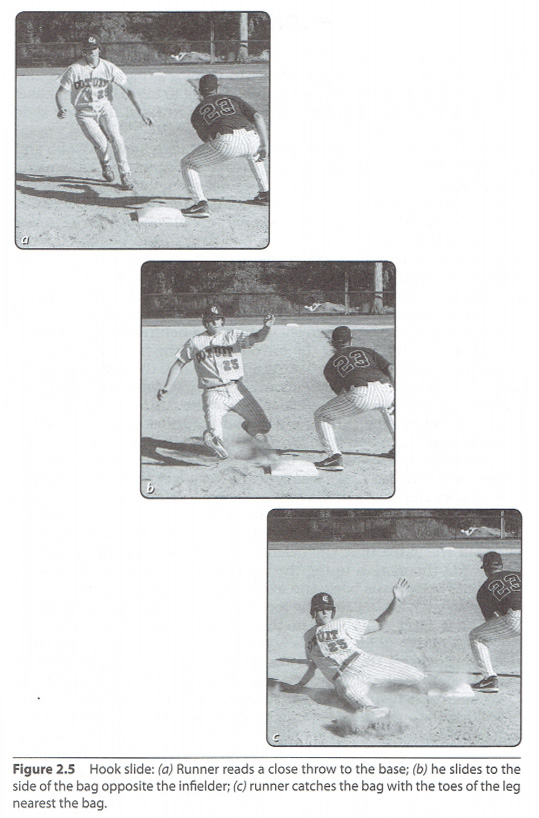|
By: Mike Roberts Originally Published in: Baserunning - By Human Kinetics Provided by: Human Kinetics The hook slide was used often in the early 1900s and made famous by Ty Cobb, but it is almost extinct in today's game. Cobb was an aggressive base runner and was often looking to take the extra base. This created many close plays during which he used the hook slide to try to avoid the tag. In today's game it is rare to see a player as aggressive as Cobb and as interested in consistently taking an extra base and possibly using a hook slide to avoid a tag. There does not seem to be a good theory or reason why the hook slide has almost become extinct in the game. The idea of using a hook slide (see figure 2.5) comes from a runner reading a throw and realizing the play is going to be close at the base. He tries to see or anticipate as early as possible where the infielder sets up in accordance with a base and the angle at which the ball is thrown to the base. The runner then slides to the side of the base opposite the infielder. He catches the bag with the toes of the leg nearest the bag. This leg is dragging behind his upper body. He throws his front leg to the far outside of the base as if doing a split. The hand nearest the base grabs the bag if the foot happens to come off the base. This slide allows the runner to wait longer to hit the ground and gives the infielder less of the runner's body to tag. Before sliding, the runner must read the infielder and know the angle at which the ball is thrown to the base. In the hook slide, the runner slides to the side of the base opposite that which the defensive player is setting up and usually waits very late to hit the ground. The runner sits down on his butt somewhat similar to the initiation of the bent-leg slide. However, as the body starts down, the lead leg kicks out away from the base. This lead-leg kickout usually happens at about the same time the defensive player is catching the ball or beginning the motion to tag the runner. As the lead leg kicks out, the upper body leans back and away from the fielder and the athlete drags the back leg to catch the toes of the dragging leg on the corner of the base. Dragging the leg on the side of the bag will slow the body down if a player slides extremely late. If the foot comes off the base, the hand nearest the base grabs the corner of the bag. When the slide is completed, the runner's legs are almost in a split position. When first learning the hook slide, run at half speed. Get the feel of kicking the outside leg forward to place the body in a split position. You can practice on a slip and slide outdoors or on blankets indoors. Once you are comfortable at half speed, practice while running full speed. Practice kicking the outside leg forward to place the body in a split position. Practice catching the foot of the trailing leg on the corner of the base. The upper body leans back and away from the base as the back leg catches the base.
Hook Slide on Dirt, Grass, Slip and Slide, or Gymnasium Floor OBJECTIVES Learn to run full speed. Slide as late as possible to the side of the base. Practice throwing the lead leg out in front of the body and dragging the other leg behind the body. This places you in a split-leg position at the end of the slide. The upper body leans back and the hands go above the head. Sometimes the upper body stays almost upright, but in other hook slides the back is almost flat on the ground depending on how much the runner needs to avoid the tag. EQUIPMENT No equipment is mandatory other than a safe area to slide. Having a base to slide into is helpful with the hook slide so the athlete can grab the bag if the foot comes off at the end of the slide. If practicing on dirt or grass, the base can be secured to the ground or laid loosely. The slide can be practiced in dirt or grass with an imaginary base. If using a base with the slip and slide, place the base on the far end of the plastic surface so players will slide to the side of the base as they exit the plastic surface. It is best to wear a helmet when practicing sliding. EXECUTION If there's more than one athlete, players form a line. One person completes the slide before the next player begins unless the drill is set up with two or three lines. The person at the head of the line sprints a minimum of 7 steps before sliding. Players begin this drill from a stealing-stance or straight-ahead sprint position and run from as far away as 80 feet (-24 m). The athlete sprints directly toward the base and begins to slide very late to one side of the base. To make the drill more realistic and challenging, consider adding a defensive player. COACHING POINTS Athletes should run full speed and learn to kick the lead leg out in front of the body. The back leg drags to slow the body down and the foot catches the corner of the base. The hand nearest the base is the safety if the foot comes off the base. The player practices a split-leg position as he slides. The upper body should lean back toward the ground and away from the defensive player to avoid a tag. |







